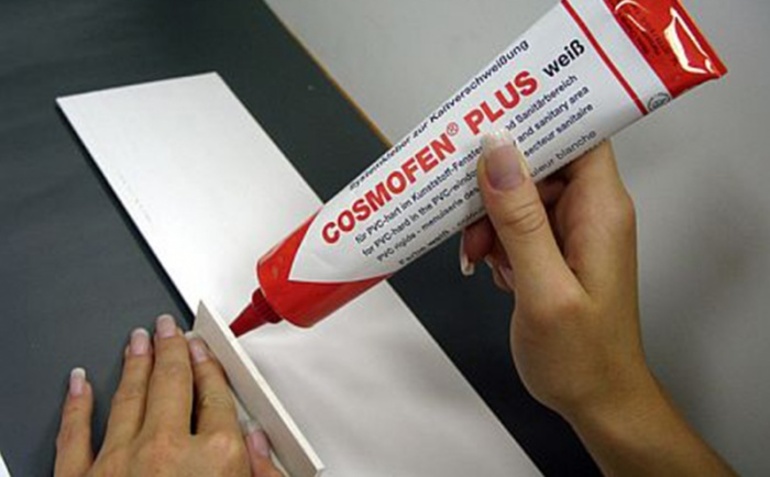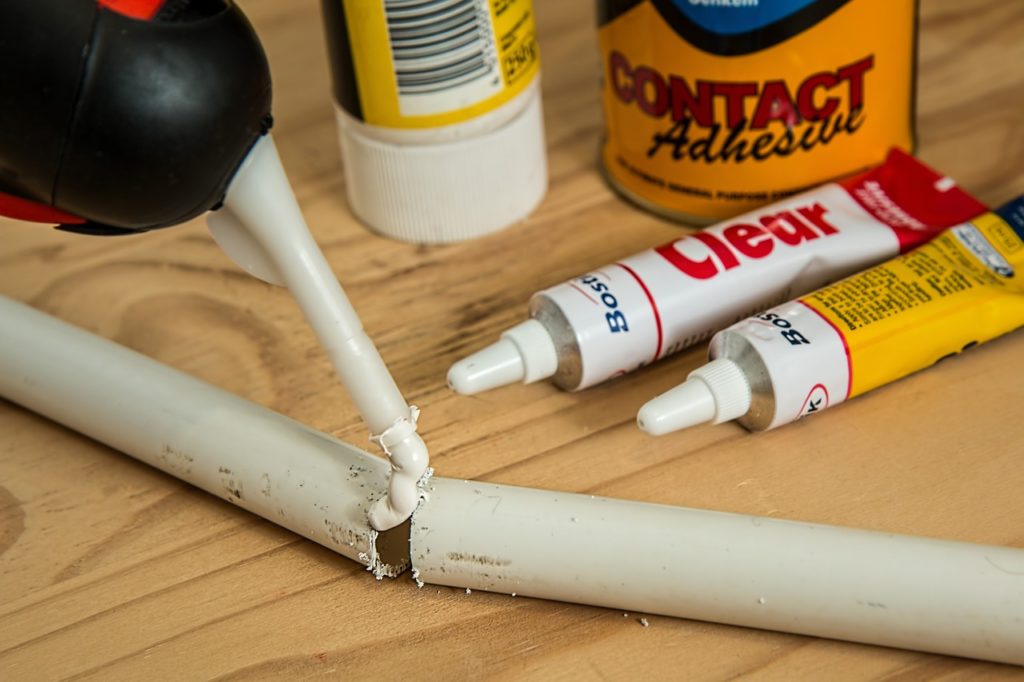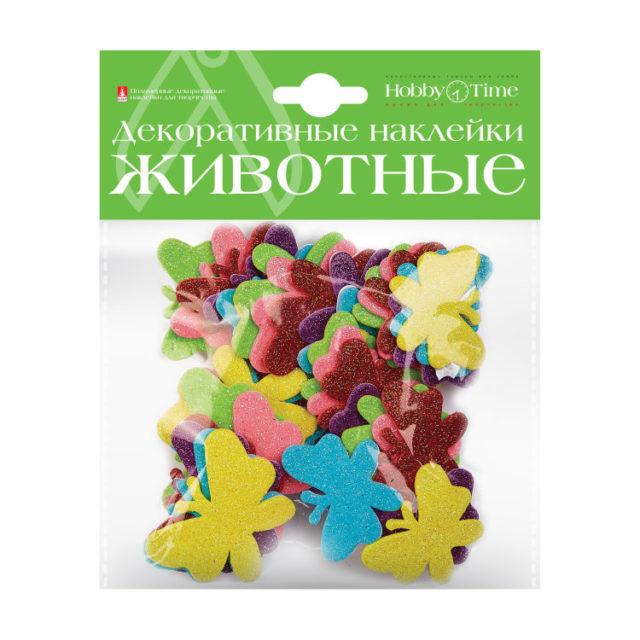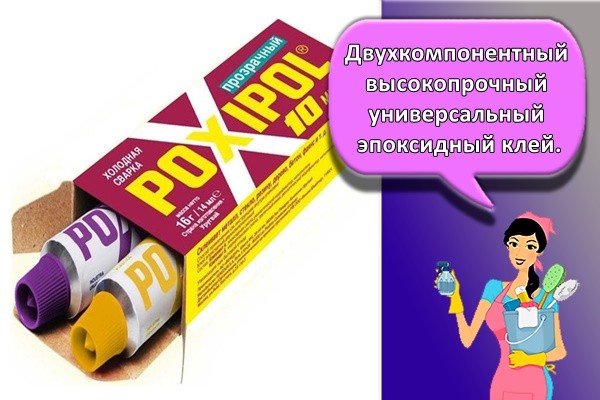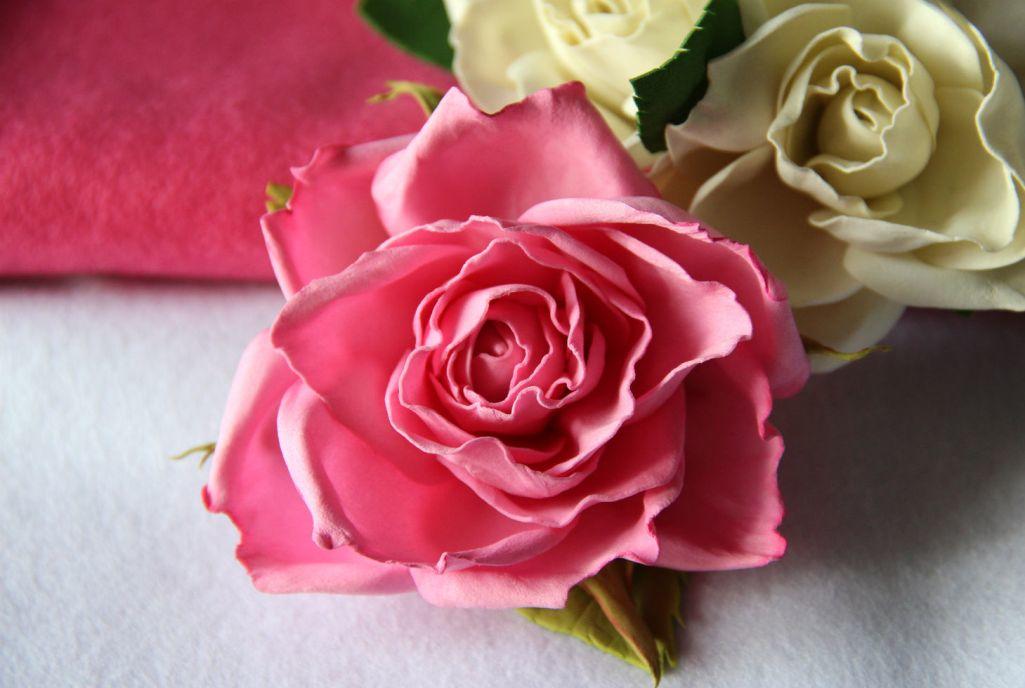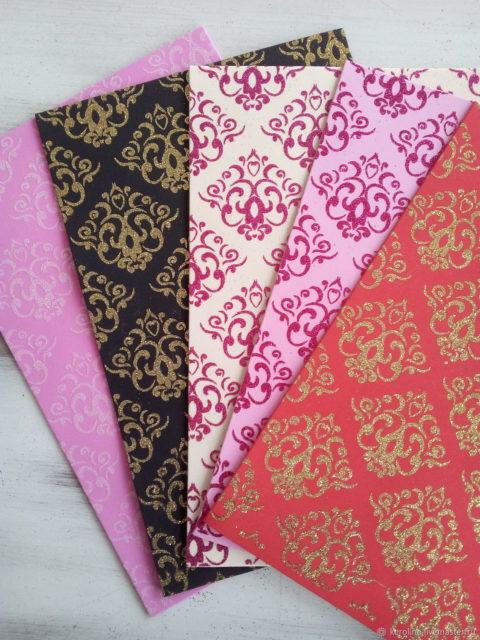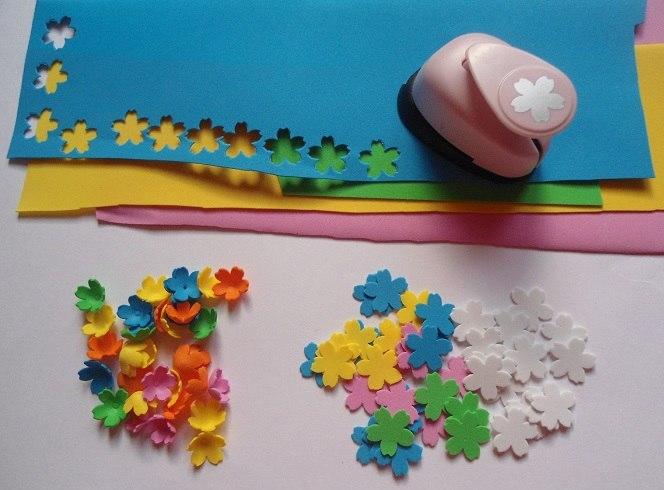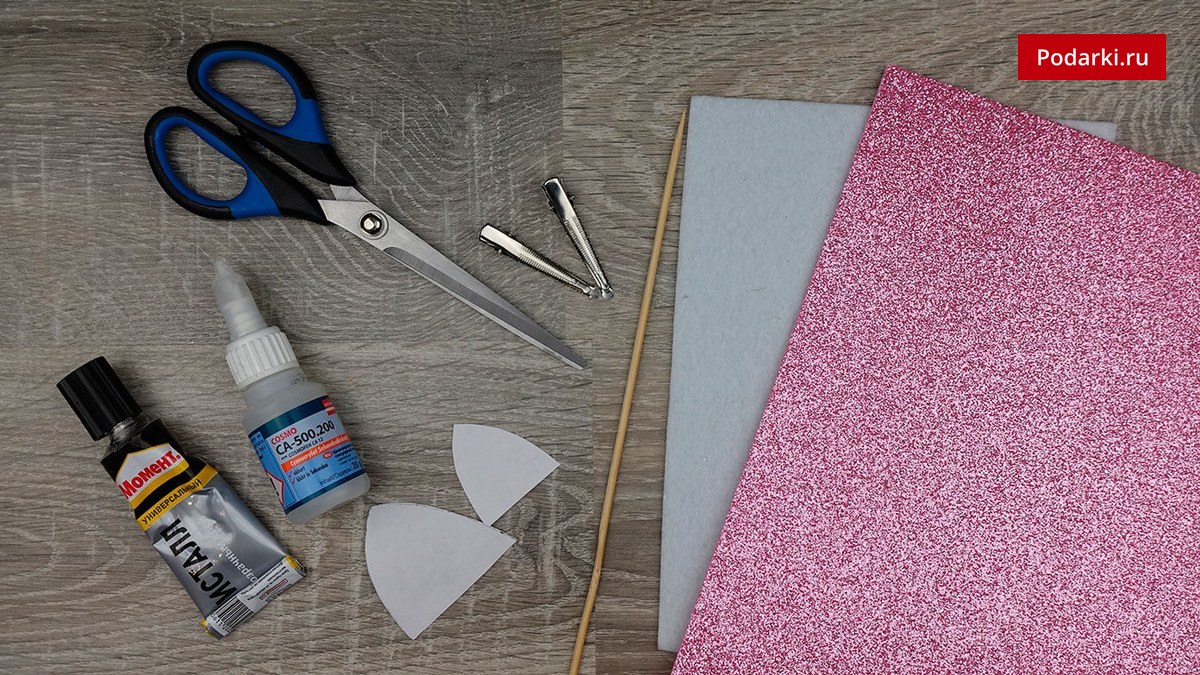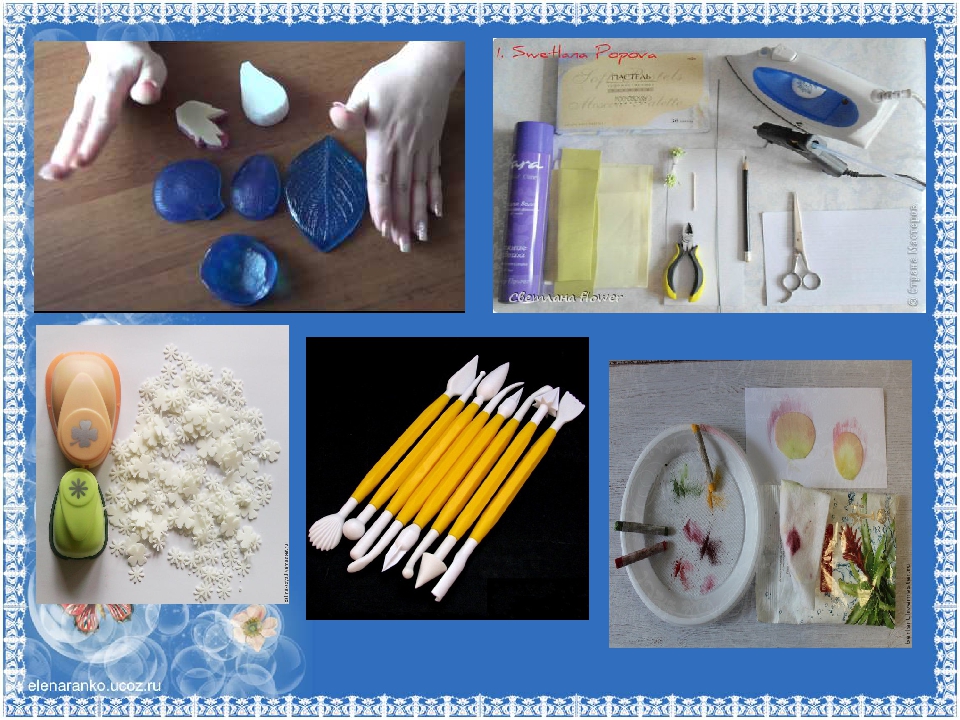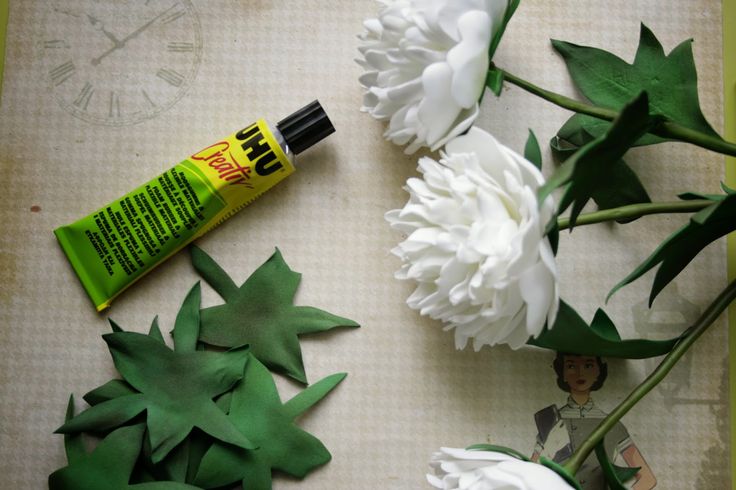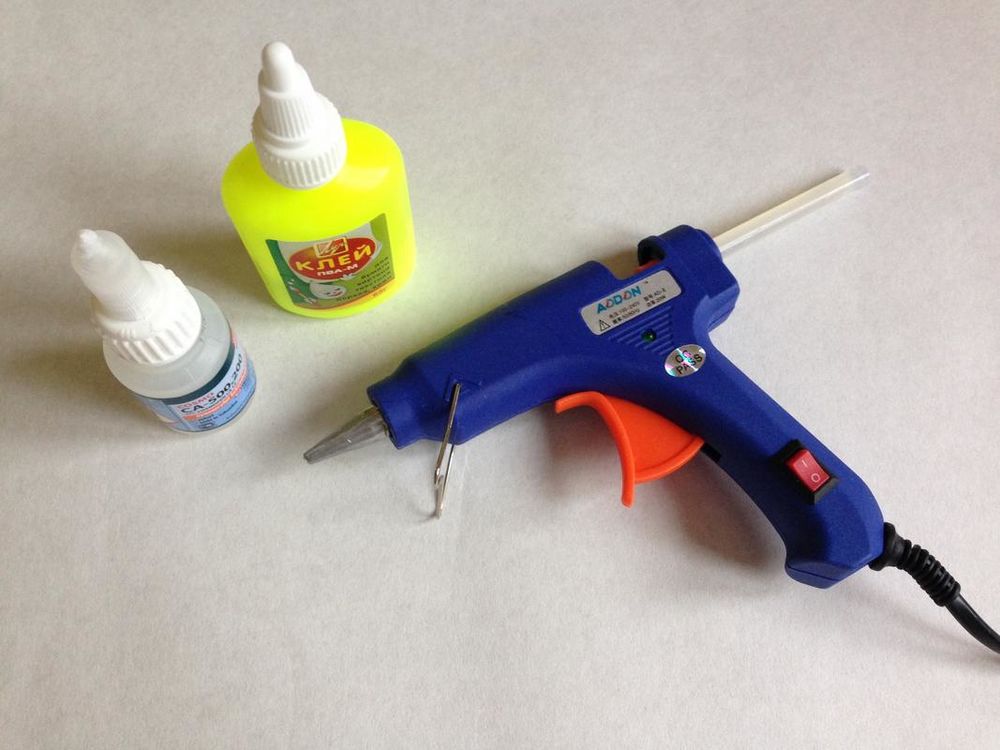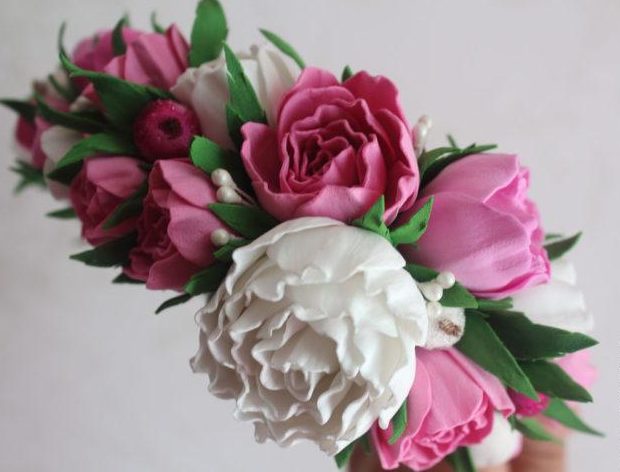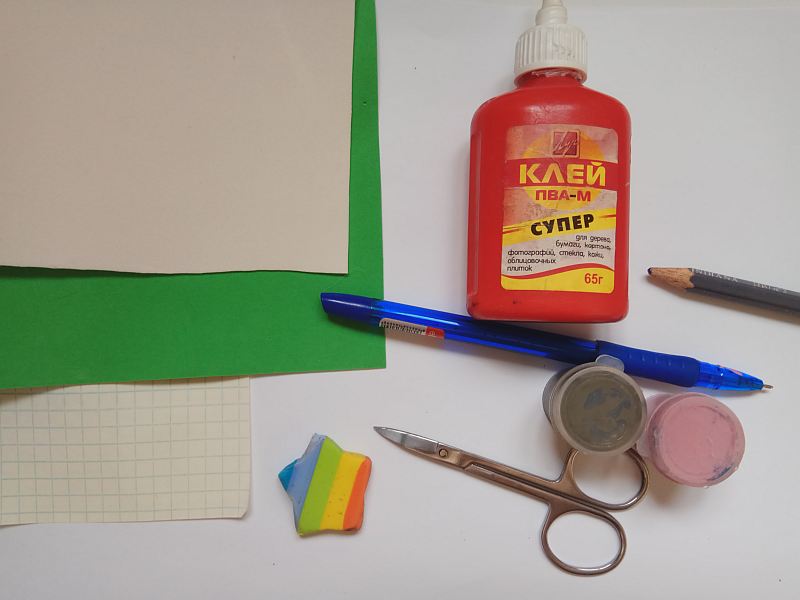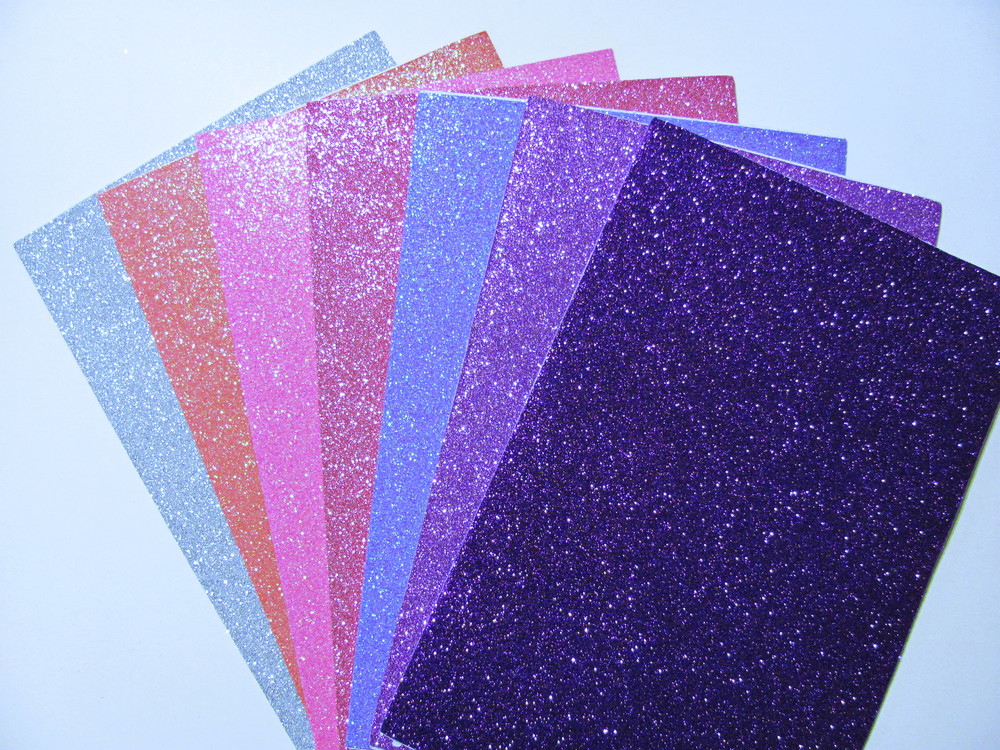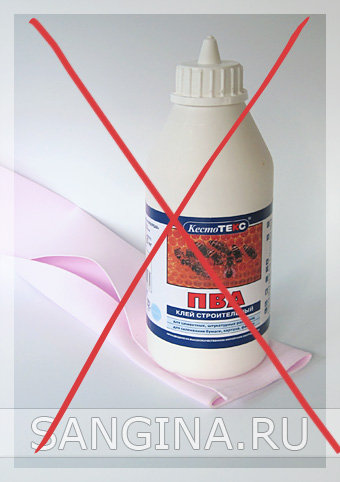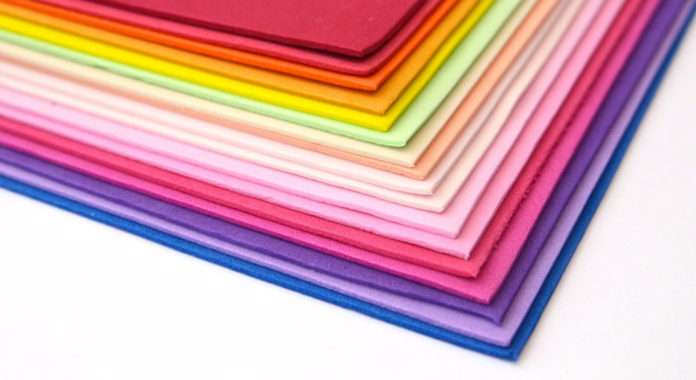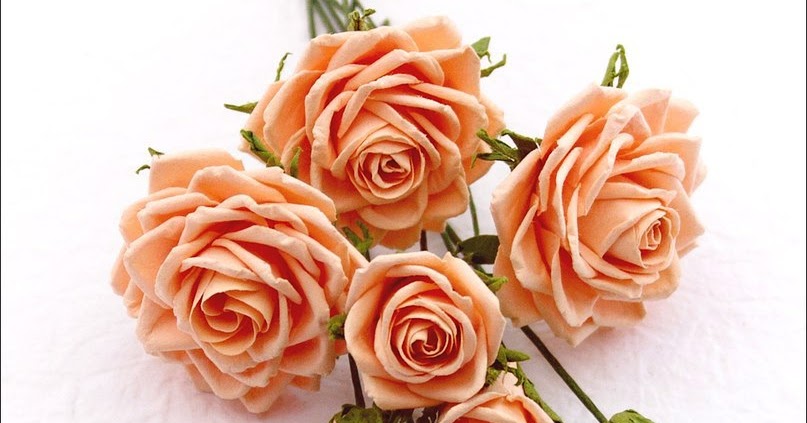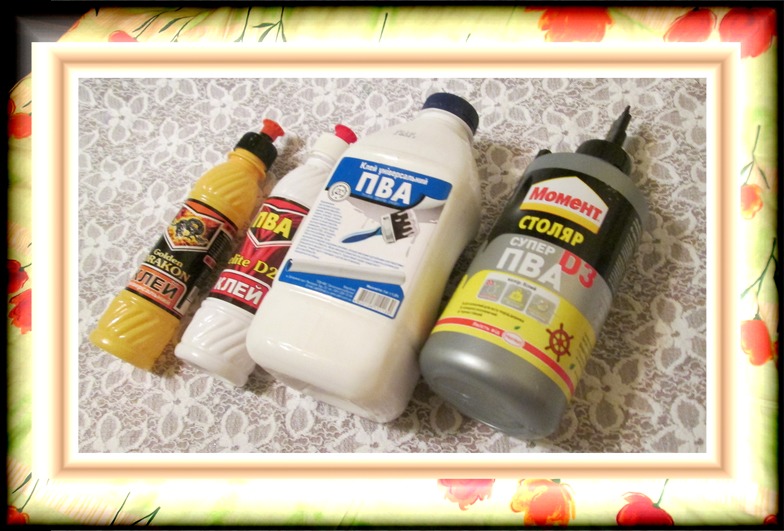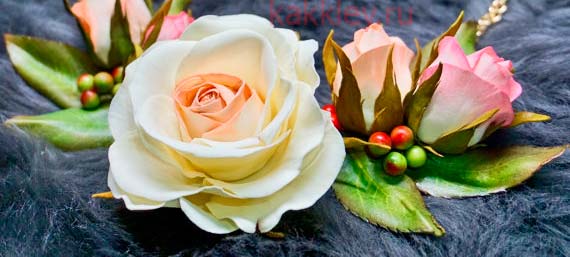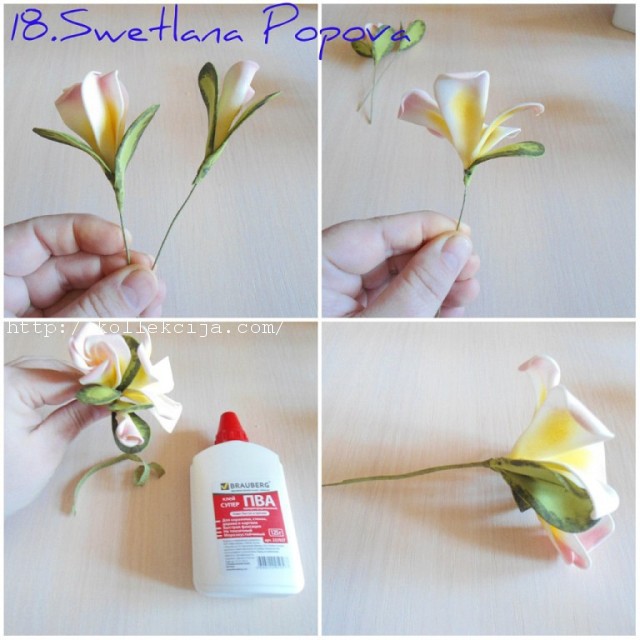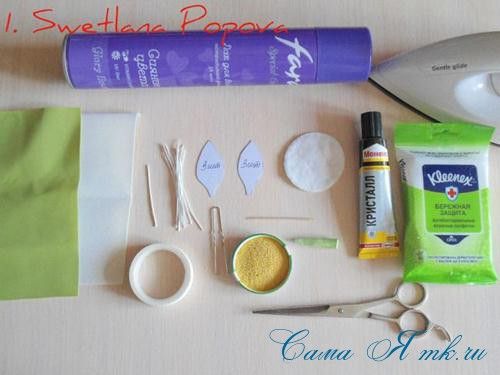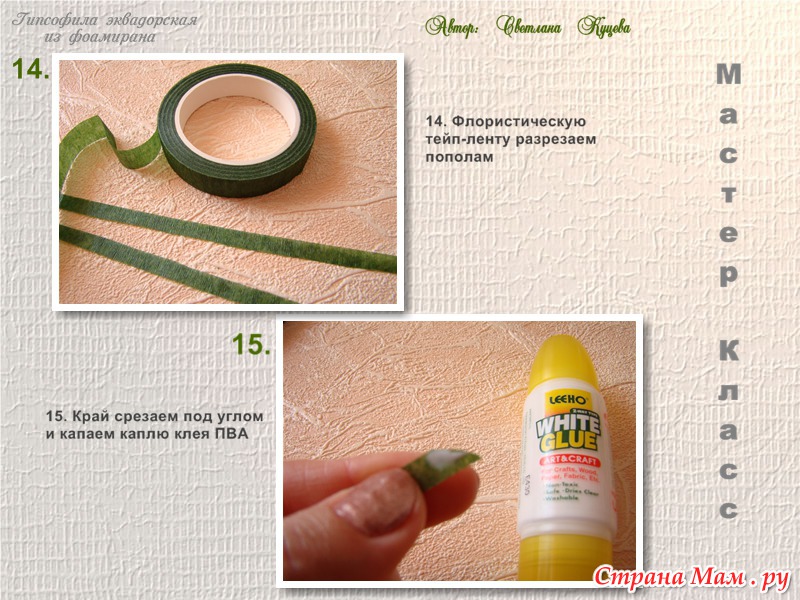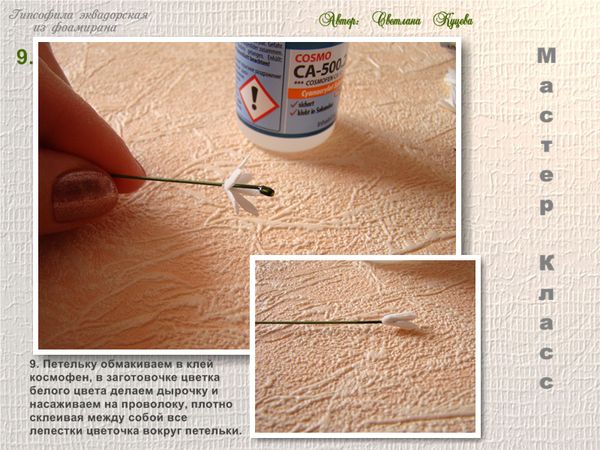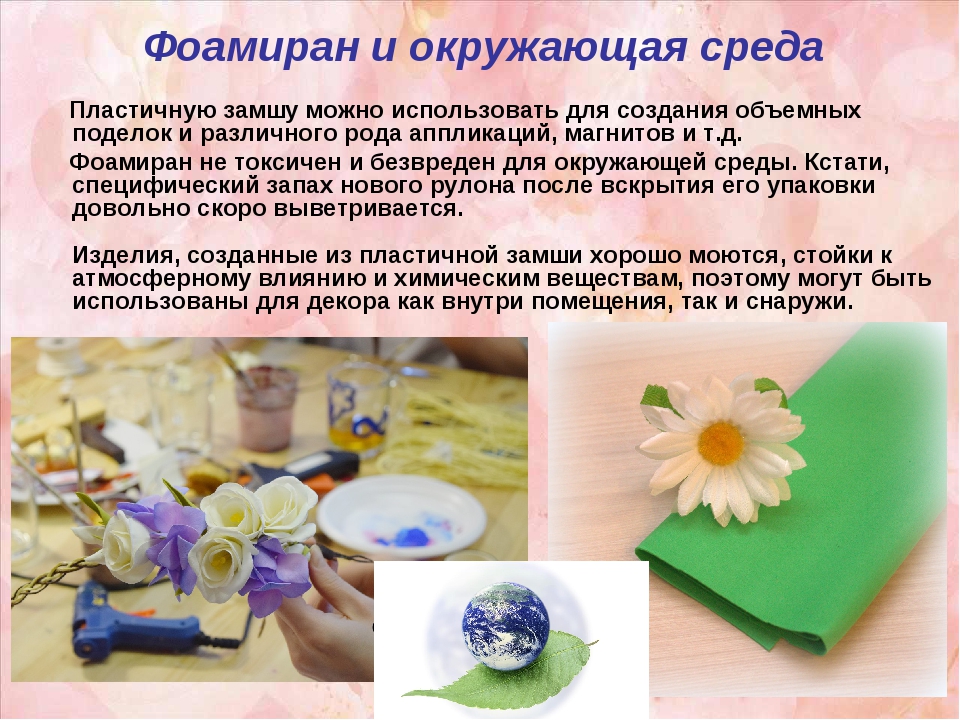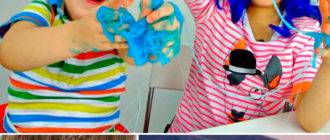Plumeria flower headband: master class from Alla Shvorak
We offer a master class on how to make a headband with a plumeria flower with your own hands.
Suitable for creating a wedding decoration or a bouquet, and will also look great on children's decorations.
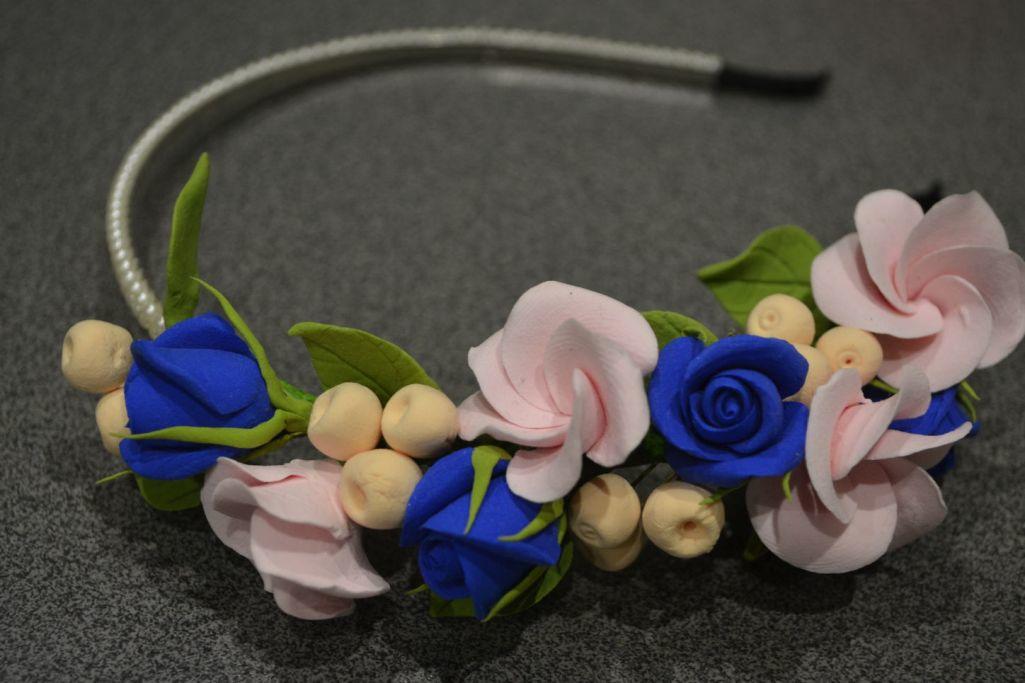 Homemade plumeria flowers from foamiran can be beautiful and unusual to decorate a hair band
Homemade plumeria flowers from foamiran can be beautiful and unusual to decorate a hair band
Materials that will need to be used to make the bezel:
- Foamiran leaf is white;
- Iron;
- Lighter;
- Yellow pastel, wet wipes, sponge;
- Second glue;
- Wire No. 26-28;
- Tape tape;
- Slim bezel.
The instructions for making a rim with plumeria flowers are simple. It is necessary to make on paper a pattern of petals measuring 4 cm by 2 cm in the form of a droplet. Cut out petals from white foamiran with nail scissors - only 35 pcs. (5 petals are needed for each flower). With yellow oil pastels, tint each petal from the thinner side with a sponge or damp cloth.
Heat the petals with an iron in the most gentle mode (silk or wool) for a few seconds and squeeze out on a mold, or apply streaks with a toothpick. Heat the edges of the petals with a lighter and quickly twist. Heat the white part of the petal with a lighter, and make a depression using a special bulka (metal ball) or improvised items.
Heat the petal again and stretch it slightly, glue the petals in a fan, 5 pieces each. Glue the wire from the bottom of the fan, the buds should be rolled up, and the first and last petals should be glued, the flower should be spread. Step back 10-12 cm from the edge of the rim, glue one flower with super glue, then, in a checkerboard pattern, glue the rest of the flowers. You can use beads, beads, satin ribbons, rhinestones.
Rules and tips for work
For gluing foamiran, it is recommended to use a gun with silicone rods. The latter provides not only a strong fixation of the material, but also facilitates the work. After gluing, the product should not be used within 24 hours. During this time, the adhesive composition will gain the required strength.
The general procedure for working with foamiran and a glue gun is as follows:
- After inserting a silicone rod into the gun, the device must be turned on.
- Warm up the gun for 5 minutes, and then pull the trigger, bringing the nozzle to the place where the materials are glued.
- Apply molten silicone evenly to the surface and squeeze 2 pieces, holding for a few seconds.
At the end of the work, it is necessary to wipe off the remnants of the molten silicone with paper or cloth. When performing the described manipulations, do not touch the nozzle of the gun.
p> Share link:
How to stick to other materials
This question plagues many home craftsmen. Styrofoam is more likely to stick to other materials than to itself. Don't worry. Manufacturers have taken into account this important point as well.
Concrete
Most often, concrete walls are insulated with foam. Dry adhesive mixtures are used to join these two materials. The old putty is removed from the wall, if necessary, putty again. Cover with soil. The mixture is diluted with water using a construction mixer. If there are shallow depressions on the wall, the foam is covered with a continuous layer of glue. If the defects are more significant, the adhesive should be applied in stripes. The foam, lubricated with glue, is pressed against the wall. The remaining glue is removed with a spatula.
Metal
Almost any adhesives are used to connect metal to foam:
- dry polymer mixtures;
- silicone glue;
- aerosols;
- polyurethane foam.
The peculiarity is that instead of the soil, a burlap substrate is used. First they glue it, and then the foam is laid on it.
Textile
It is not difficult to connect the fabric with the foam.For this purpose, any glue that does not leave stains on the surface of the fabric is suitable: aerosol, silicone, PVA. You can also use Moment-Crystal glue. It is transparent, does not leave marks and is flexible. Another easy way is to moisten the foam with acetone. Then put a cloth on it and roll it with a roller.

Glass
For bonding polystyrene foam to glass, it is best to use bituminous glass adhesive. It contains bitumen, clay and water. This composition provides good bonding of glass to other materials.
Paper
Bonding foam to paper is often necessary when making crafts. In construction work, polystyrene foam is glued to drywall. Home craftsmen advise using PVA glue or wallpaper glue for vinyl wallpaper to connect paper with foam.
Wood
Most often, polystyrene is glued to boards, plywood, lining, OSB. Connect it in various ways:
- polyurethane foam;
- assembly nails;
- adhesives.
Adhesives allow you to quickly connect polystyrene foam with wood. Most often, cement mortar is used, adding glue to it. It is resistant to moisture and neutral to temperature extremes.
Basic adhesives
When choosing an adhesive, it is necessary to pay attention to the following requirements for such products:
- dries quickly and sets;
- does not spread over the surface;
- does not contain toxic substances;
- does not exude an unpleasant odor;
- transparent.
Hot melt adhesives exactly correspond to the specified characteristics. But if necessary, other formulations can be used to work with foamiran.
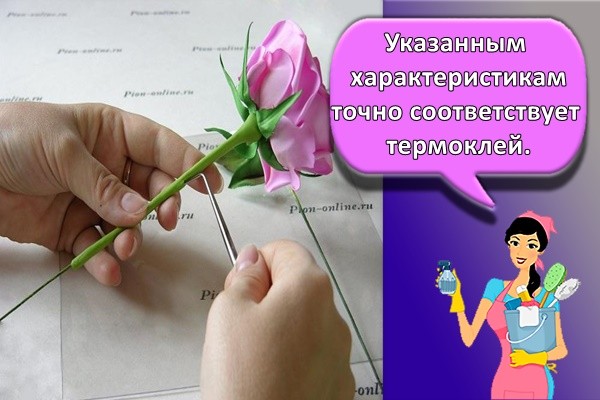
Glue gun
A glue gun is a specialized device that, by heating a silicone rod, turns the latter into a liquid substance. Foamiran is glued with this mass.
This option is convenient because:
- allows you to quickly fix the material;
- you can work with small details;
- the silicone rod does not emit toxins when heated.
The disadvantages of this bonding method include the following:
- you need to buy a glue gun separately;
- the silicone rod heats up to high temperatures, so you can get burned during operation;
- rods are consumed quickly.
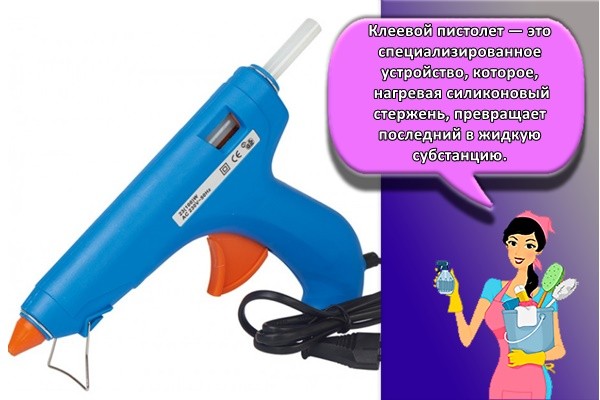
The glue gun, due to its design features (a thin "nose" at the end is provided), when the trigger is pressed, emits a small drop of adhesive, which reduces the likelihood of making mistakes during operation.
Cosmofen
Cosmofen is a versatile adhesive for a wide range of materials.
The following characteristics of the glue contribute to the popularity of Cosmofen:
- glues quickly;
- has increased strength;
- firmly tolerates the effects of the external environment (moisture, temperature changes);
- does not contain dyes.
The only drawback of Cosmofen is that it is expensive compared to other adhesives.
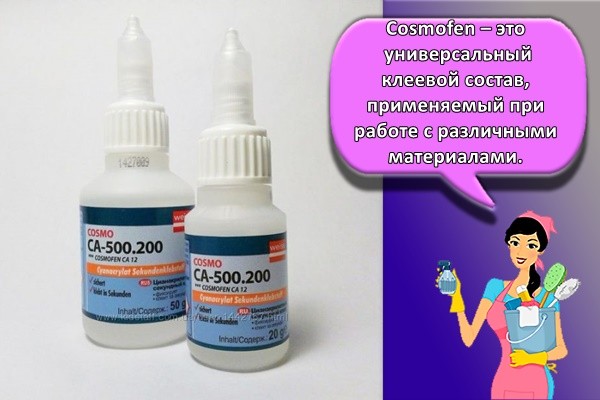
PVA
PVA also belongs to the group of universal adhesives. This composition is attractive because:
- allows you to glue various materials;
- it has a thick consistency;
- does not spill over the surface;
- after hardening, it becomes transparent;
- does not deform or soak the material;
- does not contain toxins.
PVA for gluing foamiran is rarely used. This is explained by the fact that:
- this composition provides a strong connection, due to which, after gluing, errors cannot be eliminated without damaging the foamiran;
- glue dries for a long time;
- may stain.
At the same time, PVA is cheaper than other adhesives.

"Moment"
Momentum helps to bond a variety of materials, including rubber and glass. In comparison with other similar products, this composition:
- sets faster;
- provides a strong connection;
- has a reasonable price.
But, as in the case of PVA, Moment is rarely used for gluing foamiran. This is due to the fact that this composition:
- is toxic;
- does not allow to eliminate errors without damaging the structure of the material;
- gives off an unpleasant odor.
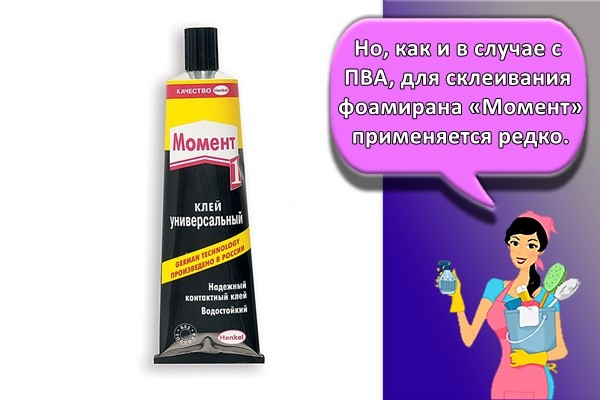
The moment is used when gluing foamiran as an emergency option, when there are no other compounds at hand.
Features and advantages of the material
Foamiran is a smooth decorative material made of foamed rubber of varying degrees of porosity. The complexity of the work depends on the last parameter. Foamiran is available in the form of sheets or rolls. This material feels like suede. The thickness of one sheet directly depends on the country of origin. For handmade work, it is recommended to purchase a thin foamiran. However, such material stretches and holds its shape worse.
Among the advantages of foamiran are the following:
- plasticity (this parameter depends on the thickness);
- the ability to hold a given shape for a long time;
- when creating compositions, you can use not only glue, but also threads;
- can be re-glued (provided that specialized glue was used).
Foamiran does not tolerate prolonged exposure to moisture, sunlight and high temperatures.
Simple work with foamiran for beginner needlewomen
Flexible suede (foamiran or foam) is the name of a synthetic material. Exported to Russia from Iran, China. The most popular brand is FoamIran, hence the name of this material.
With the help of light heating (sometimes the warmth of human hands is enough), the workpiece acquires volume. At the same time, the material is safe, non-toxic, which means it can be used for classes with children.
 To create crafts, many craftswomen prefer to choose exactly foamiran, since it is practical and plastic
To create crafts, many craftswomen prefer to choose exactly foamiran, since it is practical and plastic
The main materials and tools that will be needed in working with foamiran:
- Foamiran sheets (can be found in art stores);
- Cardboard;
- Glue gun;
- Scissors;
- Wire;
- Pencil;
- Toothpicks;
- Molds for shaping;
- Acrylic paints;
- Tape tape (adhesive tape used in floristry);
- Additional decor: satin ribbons, pastels, foil, etc.
Novice craftswomen can use printed ready-made templates for crafts.
Varieties
Parts of expanded polystyrene are glued together with various adhesives. These include:
- glue powder;
- polyurethane foam;
- polyurethane glue;
- liquid Nails;
- aerosol formulations;
- special mixtures;
- bituminous glue;
- hot melt glue.
Each of the adhesives has advantages and disadvantages. The choice depends on the goals.
Glue powder
Powdered adhesives are sold in large bags. They require dilution with water. The proportions are indicated on the packaging. The bonding quality is high. Reliability leaves no doubt. Powder glue is good for large areas. This is the most affordable option for a complete renovation in an apartment. For gluing small surfaces, it is unprofitable due to high sales volumes.
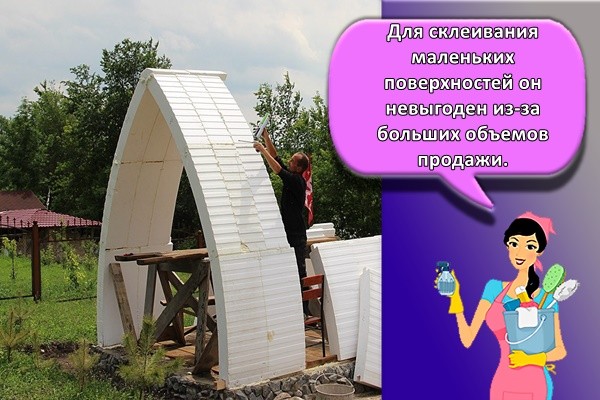
Polyurethane foam
Polyurethane foam is used as a connecting compound. It features a reliable adhesive seam and excellent adhesion to the surface. Sold at any hardware store. Disadvantages:
- Working speed - the foam hardens quickly.
- Expands when solidifying - the threat of deformation of expanded polystyrene.
- It deforms unevenly - the threat of the formation of voids that reduce the quality of the final product.
- Large consumption of material.
Conclusion: it is worth glueing the polystyrene with polyurethane foam only when the coverage area is small.
Polyurethane adhesive
This is ideal. Adhesives marked "For expanded polystyrene" are on sale. This glue glues both horizontal and vertical substrates. It has a number of advantages:
- minimum consumption;
- connection speed is high;
- convenient to use;
- tolerates moisture and low temperatures well.
Provides a reliable connection of any materials with foam. Sold in cylinders ready-made.Polyurethane spray and polyurethane foam are most commonly used for bonding foam.
Liquid Nails
Liquid nails are gaining in popularity. They provide:
- speed of work execution;
- optimal adhesion to the surface;
- speed of solidification;
- duration of service.

The adhesive is expensive. It is better to use it in small areas.
PVA
The glue is cheap. You can buy it in stationery and even in an ordinary supermarket. The composition quickly fills the voids in the wall, but does not provide the strength of the connection. For large volumes in construction and finishing work, it is better not to use it. But it is good to use for crafts.
Aerosol formulations
Aerosol adhesive is fast setting. It should be used in small areas. The composition is easy to use - it is sprayed on the surface of two objects, which are then pressed tightly against each other. For a lasting gluing, 30 minutes is enough. The fixation is reliable and durable.
Special mixtures
Special glue for expanded polystyrene is the best solution to the problem. The substances included in its composition do not deform the structure, ensure the accuracy of the seam and the strength of the connection. Special adhesive mixtures for gluing foam plastic are economical. It is convenient to work with them. Installation is quick. The choice of special mixtures is quite wide.
Bituminous glue
Bituminous glue is used to strengthen insulation and facing materials. Bituminous glue is an extensive line of bitumen-based adhesives with various additives. It is used in the form of hot and cold mastics. Cold mastics are used for interior work. Special components are added to cold mixtures for gluing various materials. Bituminous adhesive for expanded polystyrene provides a reliable connection and waterproofing of joints. Sold in various weights. Most often used for outdoor work.
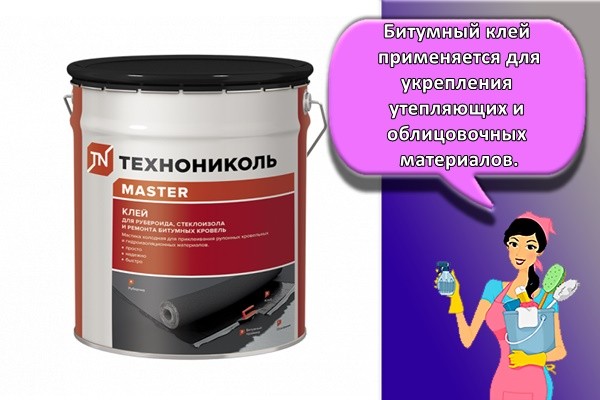
Hot glue
Hot melt glue is loved by users for its versatility. Thermoplastic adhesive has unique properties:
- strength;
- fast polymerization;
- neutrality to temperature extremes;
- lack of smell;
- hypoallergenic;
- duration of operation;
- low cost.
The glue is widely used where you need to quickly connect decent volumes. The adhesive is sold as:
- rods,
- granules,
- pillows,
- cylinders.
Excellent bonding material for small finishing works.
Step by step description of work
Using a compass, draw a 7 cm circle on the cardboard and cut it out. If you are working for the first time, you must remember that the templates are transferred to foamiran with a toothpick or a thin wooden skewer. Never use a pen, marker or pencil. Cut out 5 of these circles.
Now you need to make a flower from foamiran. Fold the round workpiece in half and make cuts to the center along the fold lines, then cut each half in half. You should get a circle with four sectors. Divide each sector in half.

Make 16 sectors of 8. Manicure scissors (you can use regular ones) first round one side in a circle, then the other. Here is such a blank for a flower decorating a hairpin, it turned out. You need 5 pieces.
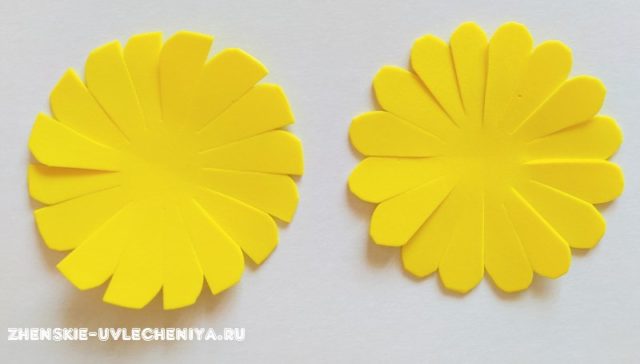
In order for the foamiran parts to take shape, they should be heated with an iron. Heat the iron vigorously and apply the part to the soleplate for a few seconds. Then place it in the palm of the folded boat, and make indentations with two fingers of the other hand. If there are blooms for flowers, then it is better to use them.
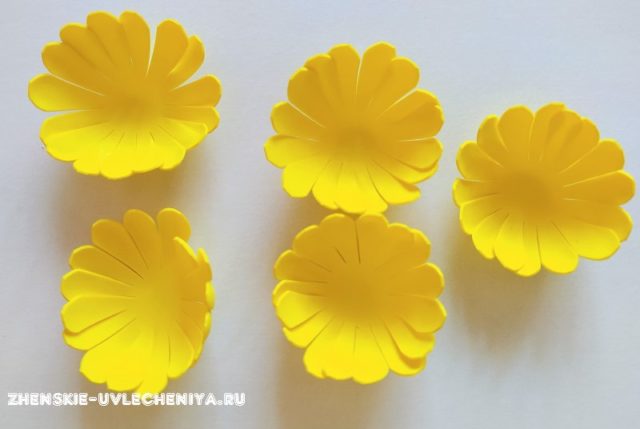
For the middle, cut out 1 * 18 cm black and brown strips each. Chop finely, very carefully so as not to finish cutting to the end. Also cut the yellow stamens 2cm * 1mm. One flower will need 15-18 pieces.
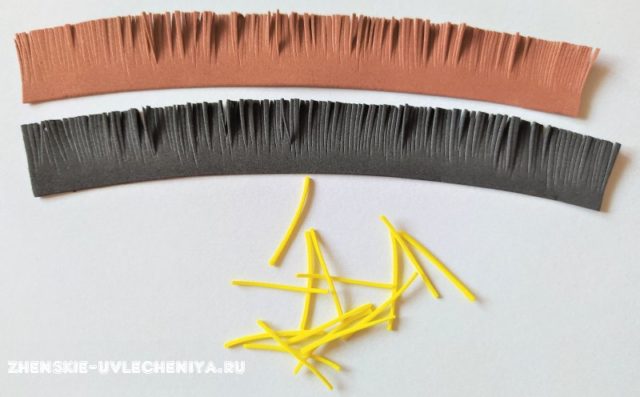
Glue one end of the brown strip onto a toothpick. Then apply hot glue in fragments to the lower part and wrap it around a toothpick.
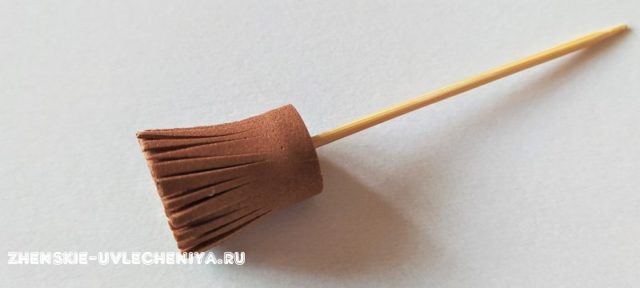

Glue the yellow stamens onto the black strip at intervals of 8-10 mm.

Wind up the black strip.
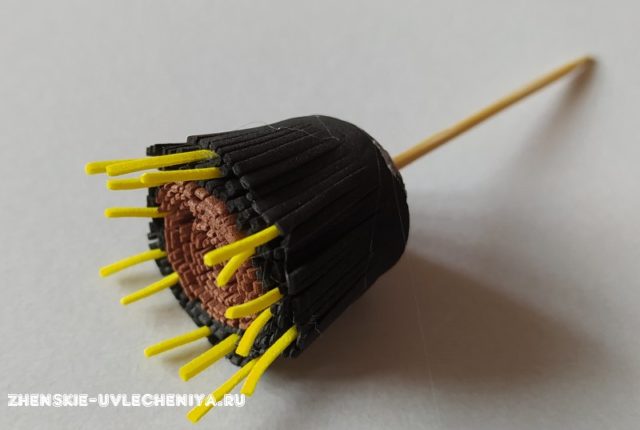
Pierce the flower blanks with a toothpick or awl. Apply glue to the back of the center and a little to the sides.
Glue the first part, press it well to the middle.
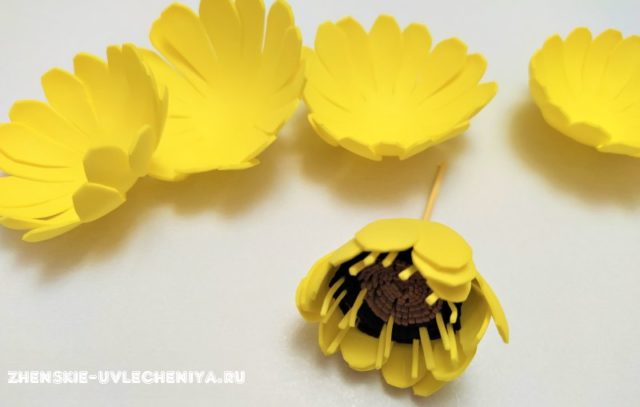
And the second piece. Place the leaves between the leaves of the previous row.
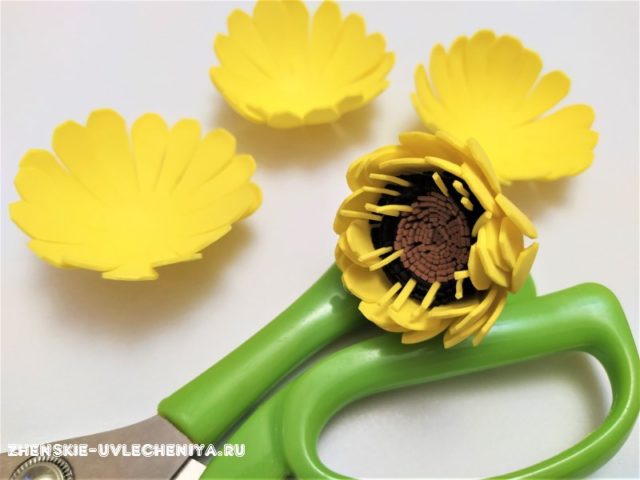
In the same way, fix the other three with glue. The flower is ready.
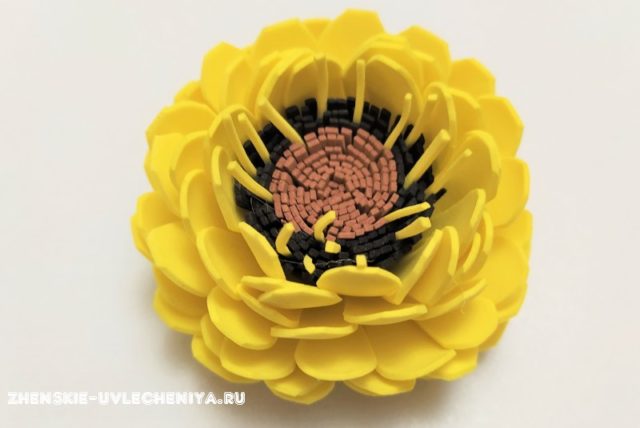
Supplement it with foamiran spirals. Cut into thin strips of green Thomas. Wind it around a knitting needle and place it on a hot iron for a few seconds. Carefully so as not to burn your fingers.
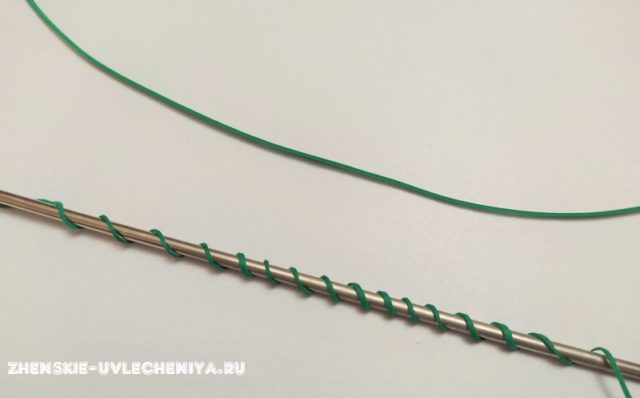
Keep this way until the knitting needle cools completely. Take it off.
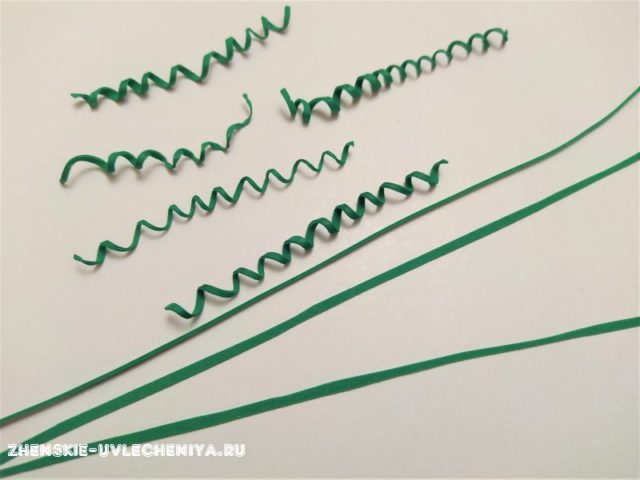
Glue three spirals under the bottom of the flower. Collect two bunches of yellow and green stamens. One goes to three double-sided stamens of each color.

Glue the bundles on both sides of the spirals.
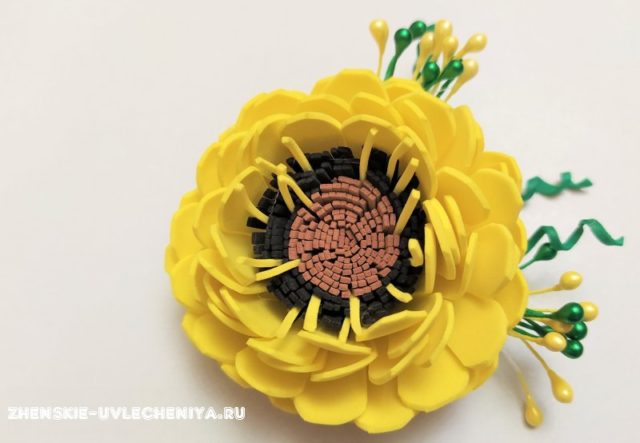
The leaves in the composition are ready. If you have not found such, then you can cut out the petals from foamiran, and draw (push through) the veins with a toothpick.

Glue the leaves on one side of the flower.

This is what a flower for a child's hairpin looks like. It remains to make the base.
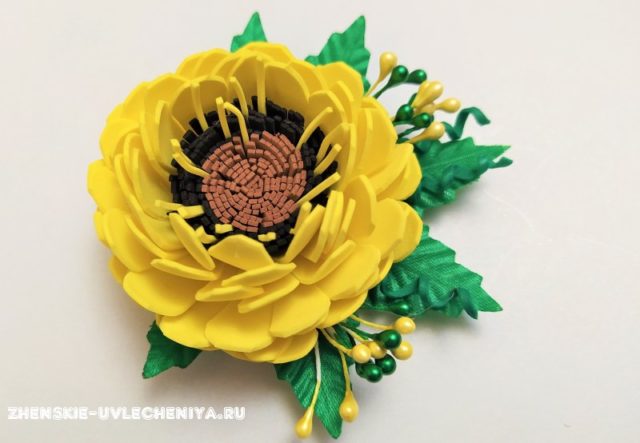
Cut a circle with a diameter of 3 cm out of green felt. Apply glue to the middle, open the clip and glue the felt.

Glue the circle to the composition.
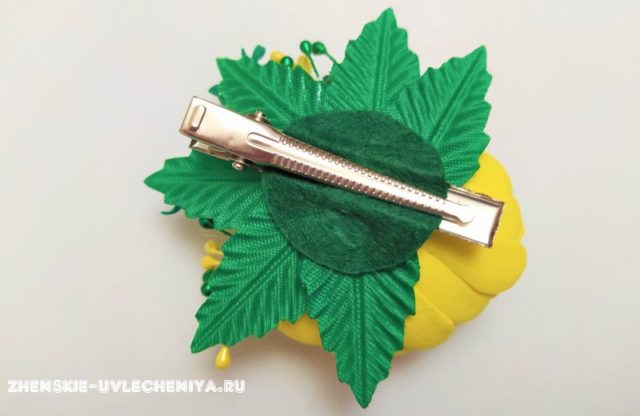
The flower turned out to be bright, juicy, uplifting!
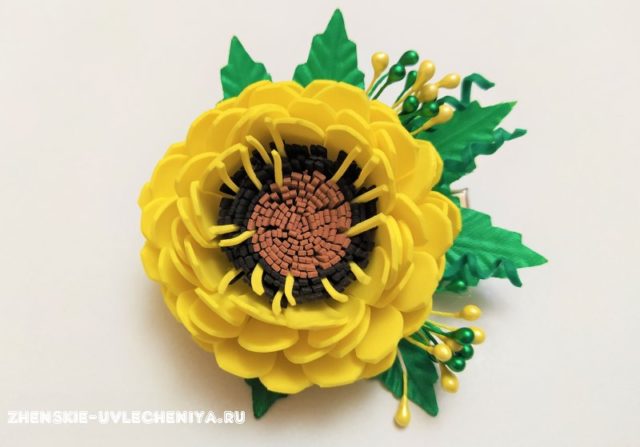
If you want two hairpins, be patient and pair it symmetrically. And even better - a lot of gifts for friends and their daughters. You can have different flowers, for example, red, purple, blue, orange!
A master class on making hair clips from foamiran with her own hands was prepared by Svetlana Sorokina, step-by-step photos of the author.
How and what to glue foamiran: options
Starting to work with foamiran, the question arises: how to glue foamiran, what to choose?
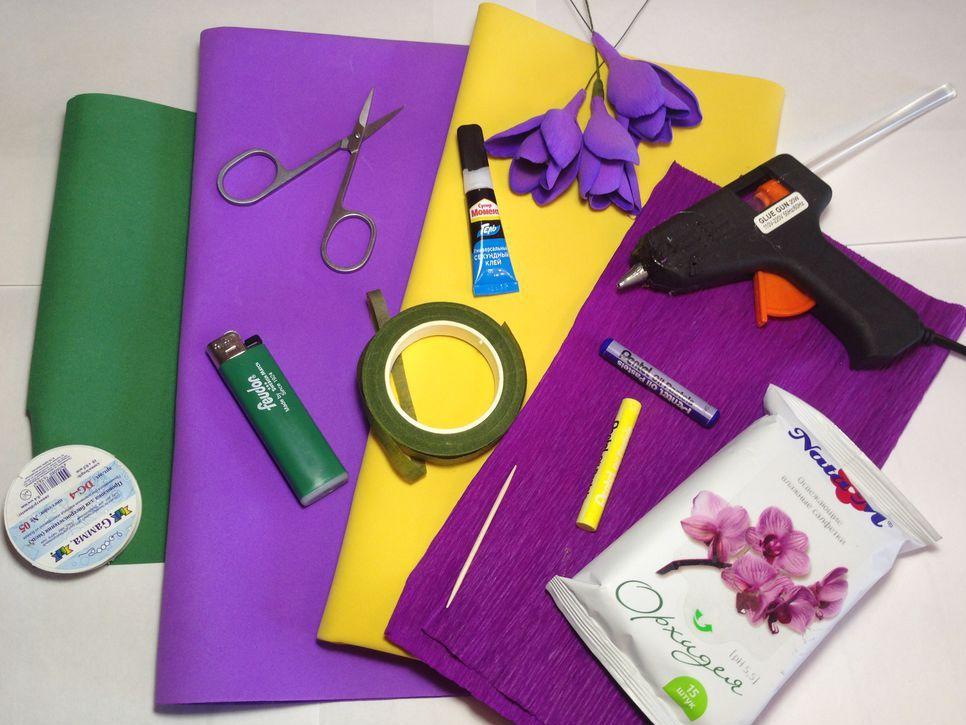 There are several ways to glue foamiran, which you can choose at your discretion
There are several ways to glue foamiran, which you can choose at your discretion
Let's figure out what the options are:
- The most popular and convenient to use for working with foamiran is silicone hot melt glue, which is applied with a glue gun. It is very convenient to use, moreover, replacement rods are sold to it. The details are quickly glued together and do not burn through, and the fastening is durable.
- In the absence of a glue gun, a cosmophene can be used. It can bond a variety of surfaces (cardboard, glass, metal, plastic, ceramics, wood). The glue is resistant to mechanical stress, at the same time it is non-toxic and can be used for making toys and crafts.
- PVA glue is very popular when working with foam. Easily glues various surfaces, creates a strong attachment, after drying - transparent, the glued surfaces do not deform.
- Glue Moment or Second - fast fixing glue, suitable for gluing small parts.
When working with adhesives, you need to be careful.
What to do if there is no glue gun - glue for foamiran
The best glue for working with foamiran is silicone glue, as it can be used with a glue gun, which is very convenient.
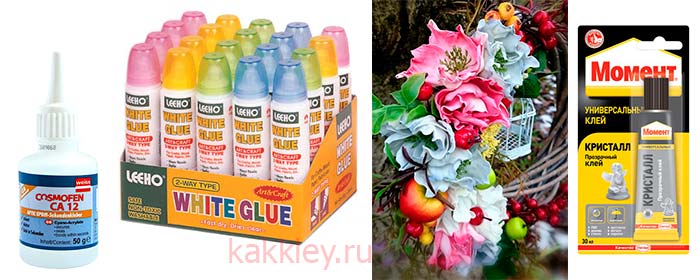
But if you do not have this tool at hand, you can use other types of glue to work with plastic suede:
- Cosmofen CA 12 (COSMO CA-500.200). It picks up many different materials, quickly fixes the surfaces to be glued, has high strength, is resistant to external weathering, high and low temperatures, does not contain dyes. It is used in the manufacture of toys, rubber processing, including foamiran, plastics, jewelry and many other industries. The cost of a tube weighing 20 g: 99 rubles.
- PVA White Glue from Leeho. Does not deform the surfaces to be glued, does not soak the paper, has a thick consistency and white color, after drying it becomes transparent. Contains no toxins. Used in cardmaking, quilling, scrapbooking and many other types of creativity.Perfectly bonds paper, cardboard, wood and fabric. Suitable for gluing various decorations to foamiran. It has two different dispensers at both ends: for spot application and for applying glue over a large area. The cost of a tube weighing 28 g: 50 rubles.
- Moment Crystal. A clear, fast-setting adhesive that is suitable for both soft and hard materials. Used for bonding rubber, PVC, paper, plastic, foam rubber, cardboard, wood, metal, glass and ceramics. The cost of a 30 ml tube: 58 rubles.

As mentioned just above, it is most convenient to use a glue gun to assemble parts from foamiran.
But, using it for foam, you need to know the rules for working with it:
Before starting work, insert a stick of glue into the special hole in the heat gun;
Plug the tool into a power outlet;
Heat the gun for 5-7 minutes;
Carefully press the trigger - if glue starts to protrude from the nozzle, it means that it has melted and is ready for use;
Unplug the gun from the outlet for 5 minutes if you do not use it for some time;
Apply glue to foamiran evenly and in small quantities, gently pulling the trigger;
Do not touch the melted glue while working with it, otherwise you may burn yourself;
At the end of the work, unplug the gun from the outlet and let it cool down;
Wipe off any remaining glue with paper or cloth.
How to make a rose from foamiran master class
To create a rose from synthetic suede, you will need the following materials:
- Foamiran of any color;
- Foamiran flower glue of strong hold or glue gun;
- Toothpick;
- Plain dishwashing sponge;
- Wire;
- Beads;
- Scissors.
VIDEO INSTRUCTION
Getting started:
- Draw three circles on paper, which will differ from each other with a diameter of 1 cm;
- Cut out the petals from the resulting circles with scissors, make them wavy at the edges;
- The smaller the circle, the fewer petals you draw on it;
- Take a sheet of plastic suede;
- Circle the figures of petals on it with a toothpick so as not to stain the material with a pen or pencil;
- Cut the petals out of the foam;


- Bend them in gurgles. They are easy to make from beads glued to hairpins;
- Heat the iron to the starting temperature;
- Attach the petals to the sole of the iron;
- When the material heats up, it will deform on its own - at this moment it must be removed from the sole;
- Put the heated foarmian on a sponge and press it inward in the center of the petals;
- It is recommended to stretch the edges of the petals - so they will become more like a real flower;
- Warp the middle of the petals. To do this, heat it and press it in with boules - the harder you press, the more closed the bud will turn out;


- Do the same for the other petals;
- To connect them, put the bead on the wire, then twist its edge so that the bead does not fall out;
- Make small holes in the middle of the petals with scissors;
- Pull the wire into the middle of the circle of the smallest petals;
- Spread glue where the wire runs;
- Lower the bead to the place of gluing and press it with petals;
- Bend the petals slightly and apply a little more glue mixture;
- Press them down so that the core of the rose turns out to be slightly closed;
- Do the same with the other rows of petals;
- Put all the following petals so that they fit slightly over the previous ones;
- You can not press the last row very much to the core - then you will get a blossoming, lush rose.
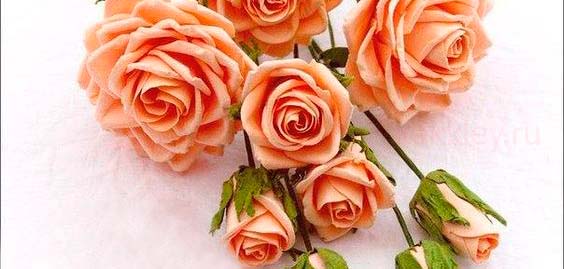
Having made several of these roses, you can create a luxurious topiary. Foamiran is an easy-to-use material from which you can create the most beautiful flowers and other handicraft materials.
Choosing what color and paint to paint for foamiran
Foamiran is sold in a large assortment of colors, but a certain shade is required in different situations.This is easy to fix, since this material lends itself to easy staining, but you need to know which mixtures are suitable for effective application and fixing. For this reason, there is a need to competently paint over your own work.
When buying paints, the following points are taken into account:
- A palette of spotting pigment.
- How this pigment is applied. He should lie down easily, evenly, efficiently.
- Durability of the coating.
- Is shading possible. Since sometimes blurry, fuzzy outlines are needed.
- Final drying time.
Optimal use of acrylic, oil paints and pastels.
Acrylic is mainly used for sketching crisp, thin lines. This type is easy to apply, shades well, dries quickly. The applied coating forms a thin film that should not be subjected to mechanical stress. This should be taken into account if the product will then be rolled up or subjected to stretching. Also, the surface should not be ironed with an iron, otherwise sticking to the iron plates will occur. The dried acrylic surface is abrasion resistant.
Oil mixtures are evenly applied, shaded, it is permissible to obtain various shades. After drying, the surface is durable to abrasion, is not affected by solar radiation, and withstands contact with water. The downside is that the layer dries for a long time, which increases the procedure for creating crafts.
Using dry pastels will allow you to easily create the desired shade in a short period of time. Shading is carried out with your fingers or a sponge. A film does not form on the surface, so the product can be subjected to twisting, stretching, and heating. Such actions will not harm the created drawing. The use of hard pastels involves the use of a moistened washcloth or napkin when applying. The disadvantage of this material is possible shedding. To avoid this, a special fixative is applied on top, or apply a spray of ordinary hairspray with strong hold.
If the finished product will not undergo folding, bending, then dry crayons, which are sold in a set, are used to give a shade. They are easy to blend with a sponge or brush.
Using any type of the considered staining, you can achieve a smooth color transition, which will add extraordinaryness to the product.
We recommend watching the video instruction:
We make foamiran with our own hands at home for beginners
If you plan to start working with this material, it will be useful to purchase a glue gun - it will make the process of assembling products quick and convenient. Although fom can be glued with common household adhesives (such as super glue), fom is a very light material and will hold up well anyway.
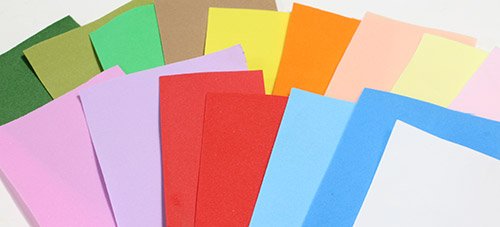
In the manufacture of flowers, molds are often used to give texture to leaves and petals, as well as bulks to create voluminous forms.
Fom can be painted with gouache or acrylic paints, pens and felt-tip pens, as well as art pastels.
Fom is easy to cut, and if you plan to use it for scrapbooking, you can use special punches for cutting out small elements.
Now on sale you can find foamiran from Iran, China, Korea, Turkey. The question arises - which foamiran is better to buy and for what. Let's take a look at what are the features of each of these Thomas feeds.
Foamiran from Iran.
Perhaps the most popular among needlewomen. It is known for its variety of shades, it is also distinguished by its fine porosity, lightness and pleasant texture of the sheets, which is probably why it is compared to suede. Iranian foamiran can be of different thicknesses, but the greatest demand is for such a foamiran with a thickness of up to 1 mm. It is the perfect material for flowers.
Chinese foamiran.
You can often hear the assertion that the quality of this Thomas is worse than that of Iranian, but this is not entirely true.Chinese foamiran from different manufacturers differs in density, texture and plasticity
There is a very thin Chinese foamiran, which must be heated with great care; there is a thicker and more plastic one. Chinese fom primarily differs from Iranian in the palette of colors - it is not so diverse, but the colors are brighter and more juicy, that is, Chinese fom can help out if Iranian manufacturers do not have the desired color
This shape is best used for decorative crafts, dolls and making elements for scrapbooking.

The so-called marshmallow (or cold) foamiran is also produced in China. This is an interesting and specific material, it is light, airy, it can melt when heated, but it stretches very well without heat treatment. You need a certain skill to work with it, but if you get used to it, then just gorgeous flowers are obtained from it.
Turkish foamiran.Korean foamiran.
In a word, each of the described types of foamiran has its pros and cons, and you need to choose a foam depending on specific tasks.
It is also worth mentioning decorative types of foamiran - terry (plush) foamiran, which is widely used for making toys, glitter - with a shiny surface, as well as foamiran with prints, embossing and various textures. New types of foamiran appear constantly, you just need to keep up with the new products.
Unfortunately, it is impossible to make foamiran on your own, since it is a high-tech material. But there are several ways how to make foamiran with your own hands at home more subtle, as well as how to independently give a sheet of ordinary fom a velor texture. You can learn about these secrets from the video tutorials given at the end of the article.

